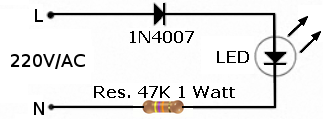rajaram04
Advanced Member level 3
Hello sir
I simply want to operate a single blue or green l.e.d. by means of 230v a.c. source without using any condenser so get me a simple circuit diagram without complications & easy to implant within a small pin plug.I made one with a single green l.e.d. in series with 100k resistor but the l.e.d. was damaged in two days so please help me
so please help me
Thanks
I simply want to operate a single blue or green l.e.d. by means of 230v a.c. source without using any condenser so get me a simple circuit diagram without complications & easy to implant within a small pin plug.I made one with a single green l.e.d. in series with 100k resistor but the l.e.d. was damaged in two days
Thanks


